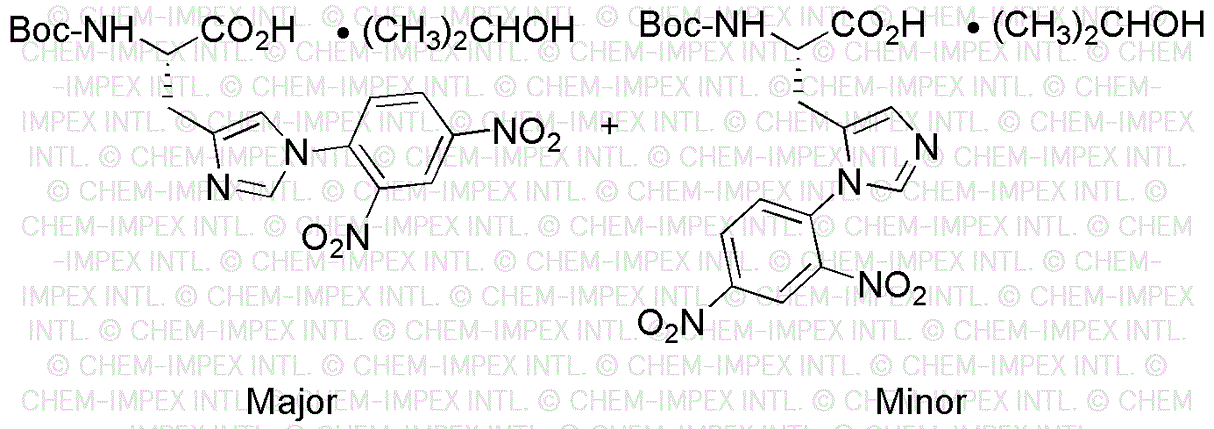Na-Boc-Nim-2,4-dinitrophenyl-L-histidine·isopropanol is widely utilized in research focused on:
- Peptide Synthesis: This compound serves as a key building block in the synthesis of peptides, particularly in the development of novel therapeutic agents. Its unique structure allows for the introduction of specific functional groups that enhance biological activity.
- Drug Development: In pharmaceutical research, it is used to create targeted drug delivery systems. The dinitrophenyl group can facilitate the attachment of drugs to specific cells, improving efficacy while reducing side effects.
- Bioconjugation: This chemical is instrumental in bioconjugation processes, where it helps link biomolecules to various carriers. This is particularly useful in creating diagnostic tools and targeted therapies in cancer treatment.
- Immunology Research: It is applied in the study of immune responses, particularly in the development of vaccines. The compound can be used to modify antigens, enhancing their immunogenicity and effectiveness.
- Analytical Chemistry: In analytical applications, it aids in the development of assays for detecting specific proteins or enzymes. Its ability to form stable complexes with biomolecules makes it a valuable tool in various analytical techniques.
General Information
Properties
Safety and Regulations
Applications
Na-Boc-Nim-2,4-dinitrophenyl-L-histidine·isopropanol is widely utilized in research focused on:
- Peptide Synthesis: This compound serves as a key building block in the synthesis of peptides, particularly in the development of novel therapeutic agents. Its unique structure allows for the introduction of specific functional groups that enhance biological activity.
- Drug Development: In pharmaceutical research, it is used to create targeted drug delivery systems. The dinitrophenyl group can facilitate the attachment of drugs to specific cells, improving efficacy while reducing side effects.
- Bioconjugation: This chemical is instrumental in bioconjugation processes, where it helps link biomolecules to various carriers. This is particularly useful in creating diagnostic tools and targeted therapies in cancer treatment.
- Immunology Research: It is applied in the study of immune responses, particularly in the development of vaccines. The compound can be used to modify antigens, enhancing their immunogenicity and effectiveness.
- Analytical Chemistry: In analytical applications, it aids in the development of assays for detecting specific proteins or enzymes. Its ability to form stable complexes with biomolecules makes it a valuable tool in various analytical techniques.
Documents
Safety Data Sheets (SDS)
The SDS provides comprehensive safety information on handling, storage, and disposal of the product.
Product Specification (PS)
The PS provides a comprehensive breakdown of the product’s properties, including chemical composition, physical state, purity, and storage requirements. It also details acceptable quality ranges and the product's intended applications.
Certificates of Analysis (COA)
Search for Certificates of Analysis (COA) by entering the products Lot Number. Lot and Batch Numbers can be found on a product’s label following the words ‘Lot’ or ‘Batch’.
Numéro de catalogue
Numéro de lot/série
Certificates Of Origin (COO)
This COO confirms the country where the product was manufactured, and also details the materials and components used in it and whether it is derived from natural, synthetic, or other specific sources. This certificate may be required for customs, trade, and regulatory compliance.
Numéro de catalogue
Numéro de lot/série
Safety Data Sheets (SDS)
The SDS provides comprehensive safety information on handling, storage, and disposal of the product.
DownloadProduct Specification (PS)
The PS provides a comprehensive breakdown of the product’s properties, including chemical composition, physical state, purity, and storage requirements. It also details acceptable quality ranges and the product's intended applications.
DownloadCertificates of Analysis (COA)
Search for Certificates of Analysis (COA) by entering the products Lot Number. Lot and Batch Numbers can be found on a product’s label following the words ‘Lot’ or ‘Batch’.
Numéro de catalogue
Numéro de lot/série
Certificates Of Origin (COO)
This COO confirms the country where the product was manufactured, and also details the materials and components used in it and whether it is derived from natural, synthetic, or other specific sources. This certificate may be required for customs, trade, and regulatory compliance.

